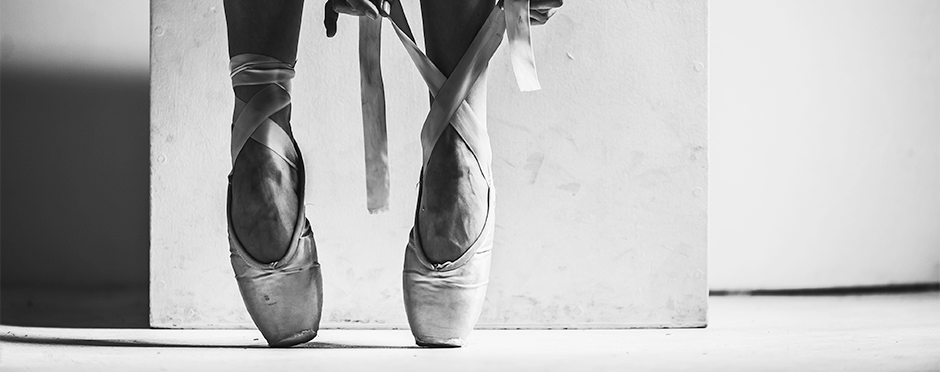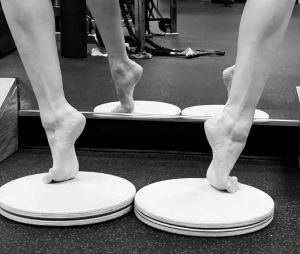
To the Pointe: Common Foot and Ankle Injuries Among Dancers
1 CommentDancers are often known for the beautiful lines and shapes they can achieve with their bodies. They are able to spin on the tips of their toes and jump high into the air, landing ever so gracefully on their feet. Due to the demands of the sport, it is not a surprise that foot and ankle injuries account for more than half of the injuries sustained by pre-professional and professional ballet dancers.1 Read below to learn about some of the most common foot and ankle injuries that impact dancers.
Stress Fracture
A stress fracture is a hairline type fracture that results from activity overload in the absence of proper bone recovery and rebuilding. Any weight bearing bone is subject to a stress fracture, but the metatarsals, the tibia and the fibula are bones most typically at risk for stress fracture in dancers. Symptoms of a stress fracture include pain that occurs with impact activities of jumping and running. If the injury is progressing, there may even be pain when walking or sleeping. A stress reaction describes bone inflammation and may be a precursor to a stress fracture. Both can be managed with short-term rest from activity and physical therapy.
Ankle Sprain
When a dancer rolls their ankle, missteps or lands from a jump incorrectly they can experience an ankle sprain, which is an over stretching or tearing of a ligament. Pain, swelling and/or bruising around the inner or outer ankle usually occurs within 24 hours after injury. If the sprain is severe, the dancer may have difficulty with weight bearing on the ankle. If symptoms do not improve within one week, specific rehabilitation may be warranted to promote safe and full return to dancing.
Ankle Tendinopathy
 A tendon is the junction between a muscle and a bone and functions to transfer forces from muscle to bone. Tendinopathy describes pain, inflammation or tendon degeneration. Sometimes a tendon, such as the Achilles, can even rupture. The flexor hallucis longus and posterior tibialis tendons are commonly injured in dancers due to the repetitive motions performed in turnout and a plantar-flexed (or pointed) ankle and foot position.
A tendon is the junction between a muscle and a bone and functions to transfer forces from muscle to bone. Tendinopathy describes pain, inflammation or tendon degeneration. Sometimes a tendon, such as the Achilles, can even rupture. The flexor hallucis longus and posterior tibialis tendons are commonly injured in dancers due to the repetitive motions performed in turnout and a plantar-flexed (or pointed) ankle and foot position.
Ankle tendinopathy can be treated with physical therapy. Treatment may include manual therapy techniques to address muscle tightness and joint motion limitations, progressive exercise loading to strengthen the affected tendon(s), dance-specific exercises to address balance and muscle control, and kinesiotaping.
Posterior Ankle Impingement
The dancer may feel a “pinching” pain in the area between the Achilles and the lateral malleolus. The impingement can be associated with inability to achieve full ankle range of motion when a dancer performs a tendu, or is in a demi- or en pointe position. The impingement can be due to bony abnormalities, joint capsule and/or soft tissue irritation in this region of the ankle.
Similar to ankle tendinopathy, posterior ankle impingement can be treated with physical therapy. In addition to manual therapy techniques and dance-specific exercises, a physical therapist may provide education on proper footwear for dance and routine daily activities, and make recommendations on short-term dance participation modifications to best facilitate return to pain-free dancing.
Cuboid Syndrome
The cuboid is aptly named because it is a cube-shaped bone in the midfoot area. The cuboid can shift out of alignment due to repetitive motions, especially in a “winged” foot position. The cuboid can also “sublux”, or partially dislocate, due to a traumatic type of injury. The dancer will have localized pain, inflammation or swelling in the foot. Cuboid pain may be treated with taping or padding techniques, wearing supportive footwear and addressing strength and mobility imbalances.
Metatarsalgia
Metatarsalgia is a term used to describe pain in the metatarsal region of the foot. Dancers may experience a “dropped metatarsal” where one of the long bones in the foot sits lower than the others. It may present as pain with demi point, or the feeling of walking on a pebble. A foot muscle exercise called “doming,” or “arch lifting” can be performed to help lift the metatarsal up. A physical therapist may additionally utilize manual therapy techniques and educate on taping and padding techniques.
Blisters and Corns
Friction forces from the floor or a dance shoe can cause a blister or corn to develop on the skin of the foot or toes. These foot problems can be prevented with properly fitting footwear, use of corn cushions to offload areas of high pressure, and toe taping to minimize skin tearing. See a podiatrist for further evaluation if signs of infection such as redness, warmth, pain, or swelling develop.
Dancing Through Injury
These injuries may result from an increase in number of hours spent dancing, muscle fatigue, technique errors, strength and flexibility imbalances, decreased sleep, poor nutrition, or improper footwear. A performing arts physical therapist will be able to accurately assess most of these injuries and create a plan of care that addresses the contributing factors to promote return to pain-free dancing. In the event of an acute, traumatic injury, especially if it is difficult to weight bear on the injured side, it is best to seek further evaluation by a physician.
If you would like to learn more from an Athletico physical therapist, please use the button below to request an appointment.
The Athletico blog is an educational resource written by Athletico employees. Athletico bloggers are licensed professionals who abide by the code of ethics outlined by their respective professional associations. The content published in blog posts represents the opinion of the individual author based on their expertise and experience. The content provided in this blog is for informational purposes only, does not constitute medical advice and should not be relied on for making personal health decisions.
References
1. Smith, P. J., Gerrie, B. J., Varner, K. E., Mcculloch, P. C., Lintner, D. M., & Harris, J. D. (2015). Incidence and Prevalence of Musculoskeletal Injury in Ballet. Orthopaedic Journal of Sports Medicine, 3(7), 232596711559262. doi:10.1177/2325967115592621

1 Comment
Mindy Jollie
That’s crazy that even the everyday activities of jumping and running can cause a stress fracture in the foot. It makes sense though, that the pressure can build up and cause that kind of fracture in the small bones. I would imagine that many dancers have to deal with this kind of injury, and may even have to take a break when they do.